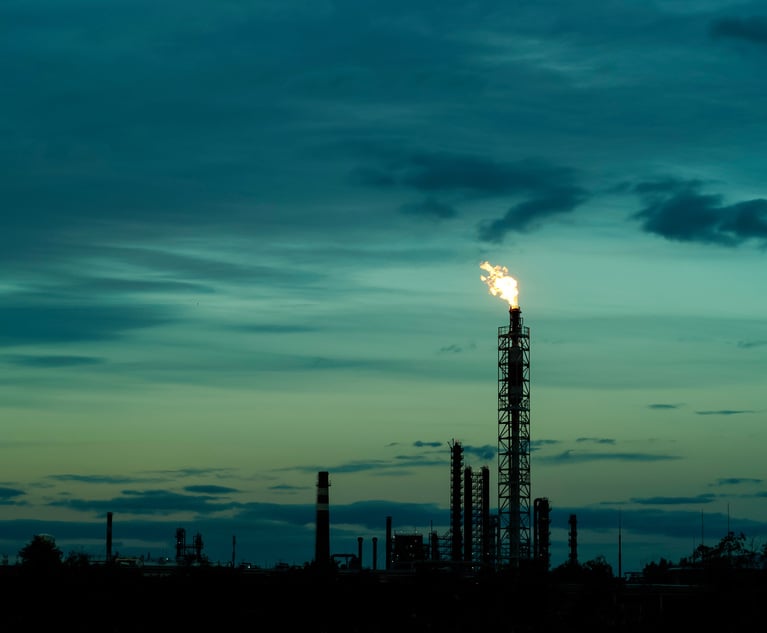OSHA Issues Guidelines for Oil and Gas Industry Workers and Employers
Even though some of the guidelines may be impractical to implement, oil and gas industry participants may wish to consider whether to implement the guidelines, in whole or part, through use of policies, signage and other methods to inform workers of these practices and procedures.
July 12, 2020 at 07:05 PM
6 minute read
 L-R: Adam Zuckerman, Kenneth M. Klemm and Jennifer L. Anderson, shareholders with Baker, Donelson, Bearman, Caldwell & Berkowitz. Courtesy photos
L-R: Adam Zuckerman, Kenneth M. Klemm and Jennifer L. Anderson, shareholders with Baker, Donelson, Bearman, Caldwell & Berkowitz. Courtesy photos
The Occupational Safety and Health Administration recently issued guidelines for oil and gas workers and employers during the coronavirus pandemic. While similar to guidelines issued previously by various governmental authorities, this guidance is specific to oil and gas industry workers and employers. The web page providing the guidance may be viewed here.
Some of the guidance appears to be more aspirational than attainable in the real world. But under laws being enacted in several states, including Louisiana, a company's adherence to governmental guidelines may help defend against claims for liability for injury or death resulting from exposure to COVID-19 during business operations. Thus, even though some of the guidelines may be impractical to implement, oil and gas industry participants may wish to consider whether to implement the guidelines, in whole or part, through use of policies, signage and other methods to inform workers of these practices and procedures.
OSHA's guidance for oil and gas industry workers and employers includes the following:
- Stagger workers' arrival and departure times to avoid congregations of workers in parking areas, locker and shower rooms, smoking areas, control rooms and other common areas.
- Encourage single-file movement with 6 feet between each worker through the facility/site, where possible.
- Provide visual cues (e.g., floor markings, signs) as a reminder to workers to maintain social distancing (6 feet).
- Designate workers to monitor and facilitate distancing.
- Limit the number of personnel allowed in doghouses, control rooms and other operating areas.
- Limit meeting sizes and/or hold meetings virtually or using social distancing outside, if possible.
- Stagger break times or provide temporary break areas, including for water breaks, and restrooms to avoid groups of workers gathering during breaks. Workers should maintain at least 6 feet of distance from others at all times, including on breaks.
- Remove or rearrange chairs and tables, or add partitions to tables, in break rooms, control rooms and other areas workers may frequent to increase worker separation. Identify alternative areas to accommodate overflow volume, such as training and conference rooms, or using outside tents for shaded break and lunch areas.
- Encourage workers to avoid carpooling to and from work and job sites.
- Consider cohorting workers into shifts and shared shuttle vehicle assignments.
- Provide workers handwashing stations equipped with soap, running water and single-use paper towels in multiple locations. If possible, choose handwashing stations that are touch-free.
- Provide alcohol-based hand sanitizer containing at least 60% alcohol if soap and water are not immediately available.
- Place hand sanitizer in multiple locations. If possible, choose hand sanitizer stations that are touch-free.
- Consider other workplace policies and programs to promote personal hygiene, such as:
- Building additional short breaks into staff schedules to increase how often staff can wash their hands with soap and water or use hand sanitizer with at least 60% alcohol;
- Providing tissues and no-touch trash receptacles for workers to use;
- Providing information on cough and sneeze etiquette; and
- Educating workers that cigarettes and smokeless tobacco use can lead to increased contact between potentially contaminated hands and their mouth, and that avoiding these products may reduce their risk of infection.
- Clean and disinfect shared common equipment such as communications headsets, operating terminals and other routinely touched items between shifts.
- Provide disposable drinking water cups or individual bottles of water in hydration stations and disposable plates, bowls, etc. in break and dining areas along with discouraging the use of shared condiment bottles.
- Workers in this industry should wear cloth face coverings, which are not personal protective equipment or a substitute for PPE. However, while noting that the CDC recommends cloth face coverings, the guidance also notes that it may not be practical for workers in this industry to wear a single cloth face covering for the full duration of a work shift, such as when they become wet, soiled or visibly contaminated. Additional recommendations designed to address certain industry-specific concerns are included for employers who determine cloth face coverings should be worn in the workplace (consult full guidance for reference).
- Workers should avoid touching their faces, including their eyes, noses and mouths, until they have thoroughly washed their hands on completing work and removing PPE.
- Workers should be careful not to touch their eyes, noses and mouths when removing a cloth face covering or other facial PPE.
- Regarding PPE, OSHA says this:
- Most oil and gas workers in normal work environments are unlikely to need PPE beyond what they use to protect themselves during routine job tasks. Conduct a hazard assessment (sometimes called a job hazard analysis) to determine the proper PPE for industrial hazards. Reminder: Face masks and cloth face coverings are not substitutes for respiratory protection from industrial hazards.
- Employers should consider whether their hazard and risk assessments warrant the use of items such as gloves or eye and face protection, if not already in use. For example, workers may need eye and face protection (e.g., goggles, face shields) when work requires being within 6 feet of other workers and when other engineering and administrative controls cannot prevent worker exposure to potentially infectious respiratory droplets.
- Consider possible additional hazards (e.g., PPE catching in machinery, limiting worker dexterity or vision) that can be created by new PPE in the work environment.
- The sharing of PPE, such as gloves, aprons and face shields, including equipment used for hazards other than SARS-CoV-2 (e.g., for mixing mud-drilling fluids that contain hazardous chemicals), should be avoided, if possible. If the PPE must be shared, it needs to be cleaned and disinfected, according to manufacturer recommendations before being used by another person. Follow proper donning and doffing procedures for PPE.
- Note that workers who perform tasks involving hazardous chemicals may also require PPE and/or other controls to protect them from chemical hazards. Employers may need to adapt guidance from this section, and the Interim Guidance for Workers and Employers of Workers at Increased Risk of Occupational Exposure, in order to fully protect workers performing activities in oil and gas drilling, servicing, production and/or processing workplaces that involve work with hazardous chemicals.
Jennifer L. Anderson, a shareholder in the Baton Rouge office of Baker, Donelson, Bearman, Caldwell & Berkowitz, is an employment litigator focusing on wage-and-hour compliance and litigation. She can be reached at [email protected].
Kenneth M. Klemm, a shareholder in the New Orleans office of Baker Donelson, is a trial lawyer with deep experience defending clients across a variety of industries, including energy, oil and gas, chemical/petrochemical, motor carrier, and marine. He can be reached at [email protected].
Adam Zuckerman, a shareholder in the New Orleans office of Baker Donelson, is the co-chairman of the firm's oil and gas industry service team. He can be reached at [email protected].
This content has been archived. It is available through our partners, LexisNexis® and Bloomberg Law.
To view this content, please continue to their sites.
Not a Lexis Subscriber?
Subscribe Now
Not a Bloomberg Law Subscriber?
Subscribe Now
NOT FOR REPRINT
© 2025 ALM Global, LLC, All Rights Reserved. Request academic re-use from www.copyright.com. All other uses, submit a request to [email protected]. For more information visit Asset & Logo Licensing.
You Might Like
View All
Big Law Firms Sheppard Mullin, Morgan Lewis and Baker Botts Add Partners in Houston
5 minute read


Houston Law Firm Files $250K Breach of Contract Suit Against 2 Former Lawyers
3 minute readLaw Firms Mentioned
Trending Stories
- 1Munger, Gibson Dunn Billed $63 Million to Snap in 2024
- 2January Petitions Press High Court on Guns, Birth Certificate Sex Classifications
- 3'A Waste of Your Time': Practice Tips From Judges in the Oakland Federal Courthouse
- 4Judge Extends Tom Girardi's Time in Prison Medical Facility to Feb. 20
- 5Supreme Court Denies Trump's Request to Pause Pending Environmental Cases
Who Got The Work
J. Brugh Lower of Gibbons has entered an appearance for industrial equipment supplier Devco Corporation in a pending trademark infringement lawsuit. The suit, accusing the defendant of selling knock-off Graco products, was filed Dec. 18 in New Jersey District Court by Rivkin Radler on behalf of Graco Inc. and Graco Minnesota. The case, assigned to U.S. District Judge Zahid N. Quraishi, is 3:24-cv-11294, Graco Inc. et al v. Devco Corporation.
Who Got The Work
Rebecca Maller-Stein and Kent A. Yalowitz of Arnold & Porter Kaye Scholer have entered their appearances for Hanaco Venture Capital and its executives, Lior Prosor and David Frankel, in a pending securities lawsuit. The action, filed on Dec. 24 in New York Southern District Court by Zell, Aron & Co. on behalf of Goldeneye Advisors, accuses the defendants of negligently and fraudulently managing the plaintiff's $1 million investment. The case, assigned to U.S. District Judge Vernon S. Broderick, is 1:24-cv-09918, Goldeneye Advisors, LLC v. Hanaco Venture Capital, Ltd. et al.
Who Got The Work
Attorneys from A&O Shearman has stepped in as defense counsel for Toronto-Dominion Bank and other defendants in a pending securities class action. The suit, filed Dec. 11 in New York Southern District Court by Bleichmar Fonti & Auld, accuses the defendants of concealing the bank's 'pervasive' deficiencies in regards to its compliance with the Bank Secrecy Act and the quality of its anti-money laundering controls. The case, assigned to U.S. District Judge Arun Subramanian, is 1:24-cv-09445, Gonzalez v. The Toronto-Dominion Bank et al.
Who Got The Work
Crown Castle International, a Pennsylvania company providing shared communications infrastructure, has turned to Luke D. Wolf of Gordon Rees Scully Mansukhani to fend off a pending breach-of-contract lawsuit. The court action, filed Nov. 25 in Michigan Eastern District Court by Hooper Hathaway PC on behalf of The Town Residences LLC, accuses Crown Castle of failing to transfer approximately $30,000 in utility payments from T-Mobile in breach of a roof-top lease and assignment agreement. The case, assigned to U.S. District Judge Susan K. Declercq, is 2:24-cv-13131, The Town Residences LLC v. T-Mobile US, Inc. et al.
Who Got The Work
Wilfred P. Coronato and Daniel M. Schwartz of McCarter & English have stepped in as defense counsel to Electrolux Home Products Inc. in a pending product liability lawsuit. The court action, filed Nov. 26 in New York Eastern District Court by Poulos Lopiccolo PC and Nagel Rice LLP on behalf of David Stern, alleges that the defendant's refrigerators’ drawers and shelving repeatedly break and fall apart within months after purchase. The case, assigned to U.S. District Judge Joan M. Azrack, is 2:24-cv-08204, Stern v. Electrolux Home Products, Inc.
Featured Firms
Law Offices of Gary Martin Hays & Associates, P.C.
(470) 294-1674
Law Offices of Mark E. Salomone
(857) 444-6468
Smith & Hassler
(713) 739-1250






